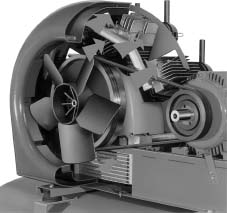<BR> Fig. 3.27: Direction of cooling air on a piston compressor
Fig. 3.27: Direction of cooling air on a piston compressor | Heat is generated in all compression processes. The degree of heating depends on the final pressure of the compressor. The higher the final pressure, the higher the compression temperature.
According to safety rules, the final compression temperature on compressors with oil-lubricated pressure chambers and single stage compression, a maximum 20 kW motor rating and maximum 10 bar may be up to 220 °C.
With higher pressures and motor ratings a maximum temperature of 200 °C is allowed. With multiple stage compression and pressures of over 10 bar the maximum final compression temperature is 160 °C.
The greatest part of compression heat must therefore be expelled. High compressed air temperatures can be dangerous as a small amount of lubrication oil is absorbed into the compressed air during compression, which could be flammable. A fire in the line or the compressor would be the least danger, but with higher temperatures the danger of compressed air explosion is potentially greater because the ratio of oxygen contained is far greater than atmospheric air.
Each compressor stage therefore has an intercooler and aftercooler installed in order to cool the compressed air.<BR><BR> |
<BR> Fig. 3.28: After-cooler as turbulence lamellar cooler
Fig. 3.28: After-cooler as turbulence lamellar cooler | The quantity of heat to be removed by cooling depends on the free air delivered and the pressure. Higher pressure compressors have two, three, or more cylinders. The cylinders are located in the best position in the air flow of the cooling ventilator wherever possible. In order to intensify heat extraction, the surfaces of the cylinders and cylinder heads are produced with generous ribbing. However, the intensive cooling and ribbing of the compressor is not enough to obtain a minimum compressed air temperature. The compressed air must also be cooled by an intercooler between the first and second stages and an aftercooler behind the second stage. If this cooling is not sufficient, multi-stage compression is necessary.
Safety regulation VGB 16 § 9 for oil-lubricated reciprocating compressors stipulates that the cooling air temperature must fall to between 60 °C and 80°C after the last compression stage. It is also beneficial for the consumer to have a low compressor air outlet temperature, because the cooler compressed air contains less moisture. Apart from this, downstream equipment, such as the compressor receiver and air treatment components can be designed for low compressed air temperatures and thus be purchased at less cost. The air outlet temperature on air-cooled piston compressors is approx. 10 - 15°C above ambient temperature, depending on the quality of the compressor. |